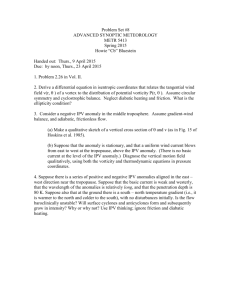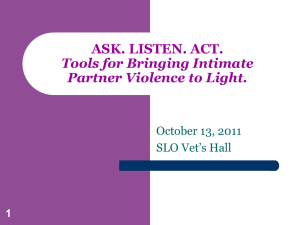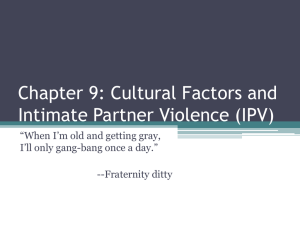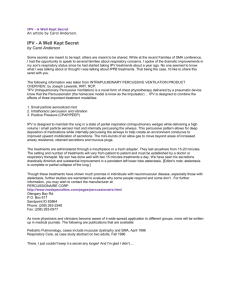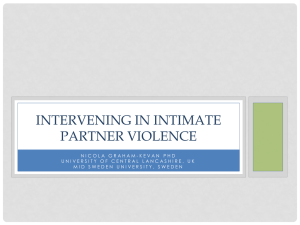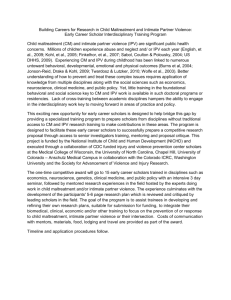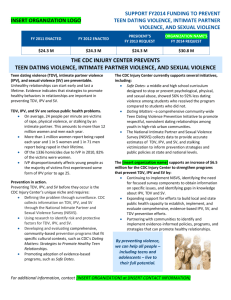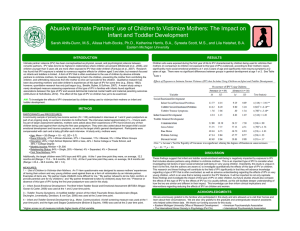Responding to Intimate Partner Violence in the Child Welfare System
advertisement
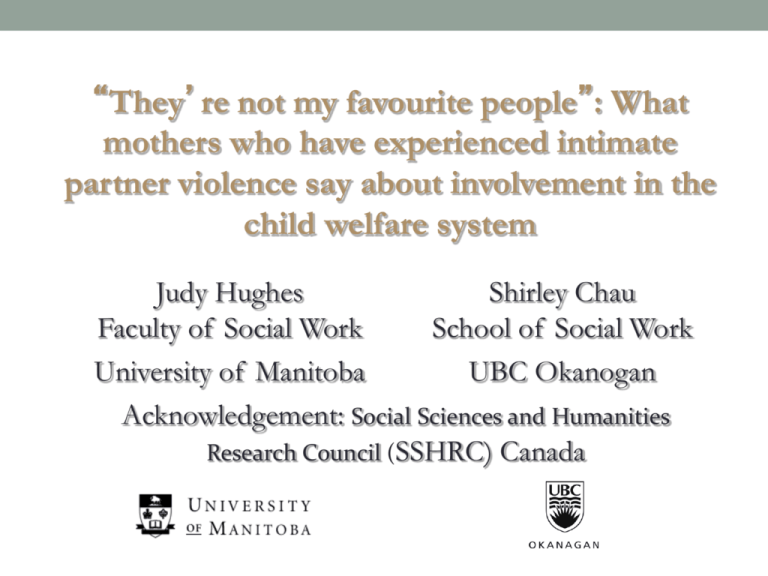
“They’re not my favourite people”: What mothers who have experienced intimate partner violence say about involvement in the child welfare system Judy Hughes Shirley Chau Faculty of Social Work School of Social Work University of Manitoba UBC Okanogan Acknowledgement: Social Sciences and Humanities Research Council (SSHRC) Canada Child Welfare: Children’s Best Interests • Controversy about the role of CPS in families where IPV is occurring • Some are critical of interventions that remove children from non- abusing parents • Others are critical when investigation focuses only on safety of children and not harm to parents • Should intimate partner violence be a concern that is addressed by child welfare systems? Jones, 2010; Rivett & Kelly, 2006 Investigation of IPV & Child Abuse • • • Substantiation of IPV– 34% of substantiated cases involved exposure to IPV (Black et al., 2008) and 43% of cases (Jones, 2010) and 14% of families investigated (Kohl, et al., 2005) Referral for services and out of home placement often involve many other co-occurring problems (i.e. substance abuse, mental and physical health problems, criminal activity) IPV substantiated, documented, and perceived as elevating risk, but service plans do not address DV directly, which may lead to future crises and referral Antle, Barbee, Sullivan, Yankeelov, Johnson, & Cunningham, 2007; Black, Trocme, Fallon, & MacLaurin, 2008; Hazen, Connelly, Kelleher, Landsverk, & Barth, 2004; Jones, 2010; Kohl, Edleson, English, Barth, 2005; Kohl & Macy, 2008 Investigation of Established Practices • Case files and interviews with child welfare workers: • Two approaches – 1) minimization (i.e. not a child welfare concern) or 2) intrusive confrontation (i.e. removal in a minority of severe situations) (Humphreys, 1999) • Focus on the impact of IPV on child functioning • Primary response is to ask non-abusing parent to protect the child – ask to leave partner (Bourassa et al., 2008; Humphreys, 1999; Jones, 2010) • Helpful responses – safety planning, seeking of protection orders and aid in obtaining resources (i.e. childcare and housing) Bourassa, Lavergne, Damant, Lessard, & Turcotte, 2008; Humphreys, 1999; Jones, 2010; Rivet & Kelly, 2006; Shepherds & Raschick, 1999; Shim & Haight, 2006. Qualitative Interviews • Felt unfairly blamed for the partners’ violence, focus on them as neglectful mothers, referral to multiple services and some that are inappropriate, and once in care concerns about their children’s well-being were dismissed • Helpful: listening, validation, and support, providing information about children, offering concrete services (i.e. housing), advocacy with other services (i.e. police), holding the abuser accountable, and placing children with trusted family and friends • Focus group with 19 Mexican immigrant mothers in New York: additional risk of cultural differences and access to services may be limited by women’s immigration status (Earner, 2010) Alaggia, Jenney, Mazzuca, & Redmond, 2007; Earner, 2010; Johnson & Sullivan, 2008; Shim & Haight, 2006 Study Purpose • Purpose: • Examine the interactions that occur between women who have experienced IPV and the Canadian child welfare system • Asked women to tell their stories of involvement in the Child Protection System • Follow-up questions to capture the temporal order of events, the reason for first and subsequent CP involvement, the interventions offered, and if women experienced their involvement as effective and helpful Study Sample • Collection of in-depth interviews: • Spring 2008: 12 women in Northern British Columbia • Spring – Summer 2009: 50 women in Manitoba • Fall-Winter 2009: 12 in Southern, BC • Women Participants: • Thirty-nine identified as Aboriginal/Metis, 22 as White, and 6 identified as Black. • Forty were between the ages of 30-50 years of age, with 14 under age of 30. • Most women had low annual income levels, 28 receive income assistance of under 10,000, 9 had incomes between 10,00020,000, 6 between 20,000-30,000, and 2 reported incomes over 50,000. Qualitative Method • Thematic Coding using NVivo 8 • Coding framework developed by coding an initial 10 interviews (chosen randomly) • Subsequent coding completed by two social work graduate students • Trustworthiness of coding: • In-depth analysis – all interviews were coded and read • Use of quotations that demonstrates overlap among participant experiences • Focus on documenting: • Mother’s expectations of CPS and the services received • Their recommendations for improvements Involvement with Child Protection • Reason for involvement varied: • IPV primary reason for some – either referral by others or woman herself seeking help with partners’ behaviours • Others wanted to protect their children from witnessing further violence or time for themselves to seek help for substance abuse or mental health issues • Some stated that their involvement was from childhood and then just continued into adulthood • A final group reported that their involvement was short as they were simply told that there were no services for them Involvement with Child Protection • Involvement with CPS as mysterious, women uncertain: • About reason for investigation, • How the multiple referrals to parenting programs, etc. will help them specifically, or • Reason children were removed • “I guess the reason why they took my kids because I was abused. They never told me what happened. I guess the next door neighbours phoned, and they didn’t tell me how come they’re taking my kids for the longest time. I kept asking. I asked for visits and they wouldn’t give them to me” (woman 17MB). Involvement with Child Protection • Others stated they believed that their involvement had to do with some aspect of their identities: • “I am viewed as nothing but a drunken Indian” (woman 03NBC) • “Oh well, you’ve got mental health issues” (woman 04MB) • “I think it was like really more because I was young” (woman 61MB). • “There’s a little box and you guys aren’t letting me out. That’s what it felt like, I’m not my mom, and I’m not my dad. It was like they never gave me a chance but not they just put me in a little box and closed the lid and made me live by their rules and it wasn’t fair at all” (woman 07NBC). Recognizing Intimate Partner Violence • IPV was a part of all women’s stories, which also included substance abuse and mental health issues • Some women reported that “nobody wanted to listen:” • “And I went to her and I had a big black eye and they asked me where I got it. I had to lie to them because he was standing right there, I never said nothing or else. When I went by myself once, the worker goes, I know that black eye you had wasn’t from somebody else, I know it was from [the partner]. Are you scared to be there? I said, no, when the kids are around like he’s not so bad” (woman 42MB). Recognizing Intimate Partner Violence • Contact began because of abuse from partners, but then focus was on their abilities as mothers: • “Instead they got involved because of the domestic violence and he went to jail and then it’s like they found things to stay involved in my life. Now they are right in there and it is just driving me crazy” (woman 28MB) • Quick to remove children or limit contact between children and father/partner: • “He’s not allowed to go around our children whatsoever, it’s a no contact order and its permanent” (woman 13MB) • “They told me the only way is to leave him. I went into a treatment program over 2 years ago and I kept him out of the picture. Well, he still try’s to get involved, but CPS won’t allow him, only if it goes thorough a supervisor” (woman 29MB). Lack of Understanding & Help • Interaction with CP workers is mainly assessment, rather than any concrete help or safety planning: • “I wanted some emergency something. I thought they would put me in a safe house. I told them I gave her up for her safety. I felt that I let her down, by giving her up too soon” (woman 19MB). • “They think, she’s not ready to get those kids back yet, no she is not safe enough, she is putting the kids in danger and things like that. No, give me my kids back and move me. If I’m not safe enough to be here than don’t keep me here, take me away, but I want my kids with me” (woman 16MB). Accountability to Them as Mothers • “They took her because; it was definitely because of the abuse. CFS wouldn’t let me have my daughter back unless he wasn’t in my home. So he had to leave my home. And they told me, that if I ever, like if I’m seen with him or my neighbours see him with me or if anybody you know, if anyone sees, they’ll take my kids away from me again. THEY JUST SAID THIS TO ME, NOT HIM. I just had to make sure he left and he wasn’t around, it was put on me, like THE ONUS WAS PUT ON ME. I had to be responsible for my children. I THOUGHT IT WAS BULLSHIT TO SAY OKAY IF HE COMES AROUND, I DIDN’T, IT’S NOT LIKE I INVITED HIM HERE. If I’m ever in a relationship and this guy happens to be alcoholic they’ll come and take my kid away I was told. If they’re violent to me or even anything cause I’m flagged” (woman 86MB) Sense of Powerlessness • Powerless: No information about their children and concerns about the foster care arrangements • Loss of the right to continue to care for and about children was described as very difficult: “I’ve been robbed of a relationship with my daughter because I feel CFS has taken her into care, but my worker tells me nothing" (woman 04MB). • Other women were content, if they knew where their children were placed and had some continued contact with them: “eventually she went into care and the good thing about it is all these children of mine all ended up with my one aunt on the reserve. So, it’s not like they took them away from me and I didn’t know where they were” (woman 34MB). Recommendations Variation if IPV is recognized and interventions offered: Training to ensure uniform interventions • Recognize the interconnections between IPV and mental health and substance abuse issues (these were clearly connected in the stories) Involvement with CPS as mysterious: Communication about investigation and intervention (women asked that workers be genuine, honest, and provide information) Recommendations Lack of concrete help: Safety planning: some women wanted workers to speak to abusive fathers and others wanted to be moved with their children (Jones, 2010) Resources– housing, income assistance, and legal protections (Bourassa, et al., 2008) Continue to work with mothers even after children are temporarily or permanently removed Information about children is vital – knowledge of where children are placed and continued contact (i.e. pictures or visits) Conclusion • Findings demonstrate the impact of child welfare practices in women's lives and reveal where changes to practices and interventions are necessary • Should intimate partner violence be a concern that is addressed by child welfare systems? • If IPV is substantiated and addressed
